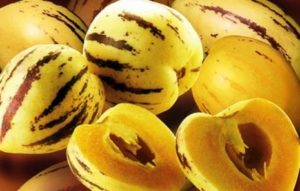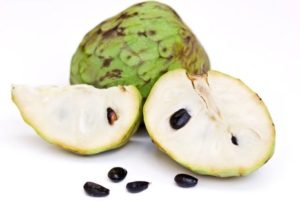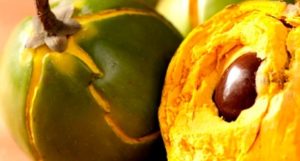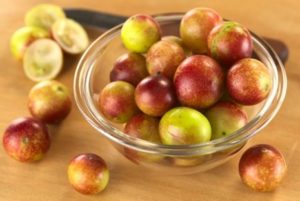The Best Peruvian Fruits: An Exotic Diversity
April 9, 2018Peruvian fruits are the result of some of Peru’s blessings – it’s amazing biodiversity and variety of climates and regions. The wide range of exotic fruits and vegetables in Peru along with other factors such as cultural fusion is the reason for the success and international recognition that Peruvian food has nowadays. A couple of our previous blogs have talked about food, so today we take a closer look at 5 Peruvian fruits you should definitely try during your visit to Peru.
Traveler’s tip: If looking for a hands-on Peruvian food experience, you can take cooking classes and food tours in many places in Peru. In particular, to look for top operators and get the best value for your money, we recommend findlocaltrips.com; a search and comparison website for tours across all of South America.
Some exotic fruits found in Peru are what experts call “super foods” for the amount of nutrients present in them. Such fruits have also been said to cure diseases and ailments. It is no surprise then that many Peruvians pay regular visits to their nearest “juguería” (juice bar) where they get freshly made shakes of their favorite fruit or fruit combination.
Did you know that tomato is actually a fruit? Even more, it was unknown to Europeans until it was first introduced to the Spaniards in Mexico, but its origins are traced back to Andean regions where there are some more varieties of tomatoes as well.
Discover with us 5 interesting fruits that you do not want to miss sampling when you visit Peru:
Pepino dulce (Solanum muricatum)
Pepino dulce, referred to as sweet cucumber in English, is a tomato cousin which is quite versatile and can be served with any meal. It is low in carbs and has a number of health benefits. For example, its large number of antioxidants such as beta-carotene helps slow down the aging process. Its diuretics properties benefit its daily consumers by reducing high blood pressure which also helps avoid cardiovascular disorders and even heart attacks. Moreover, sweet cucumbers have a decent amount of vitamin A that improves vision, strengthens the density of bones and teeth, promotes skin health and prevents urinary stones. It is also abundant on soluble fiber which greatly helps the body to avoid constipation.
Inside, they look a bit like honey dew melons and they can grow about as big as goose eggs. Their watery interior is somewhat sweet, pleasantly flavored, and you could actually eat the whole thing without getting rid of the seeds because they are soft, tiny and edible.
Aguaymanto (Physalis peruviana)
This fruit had a privileged spot in the house gardens of the Inca nobles. These “little golden spheres” are bittersweet and come wrapped in a light brown inedible peel of paper-like texture. It contains vitamin A, vitamin B complex (thiamine, niacin and vitamin B12) and large amounts of vitamin C. In particular, large concentrations of vitamin C will help enhance your immune system so that you, for example, will be less likely to suffer from colds, flu and other related illnesses. Additionally, studies indicate that aguaymanto lowers the amount of cholesterol and stabilizes the level of glucose in the blood, which makes it a great fruit to have in the diet of diabetic people. Other benefits include; combating mental fatigue, promoting healing of wounds, reducing the symptoms of menopause, and so on.
ENTERTAINMENT TIP: If looking for fun at night, or to watch sports during the day, or even a taste of home, visit the Wild Rover Hostels Chain for great food, sports and beer! Entrance to their bars is free even for non-guests
Aguaymantos in Peru are consumed in many ways including jams, yogurts, sweets, ice creams, cakes, and liqueurs. However, we recommend you consume it fresh out of the crops to take advantage of their full benefits.

Chirimoya (Annona cherimola)
Its name is derived from quechua, a native Peruvian language, and is composed of two words: chiri «cold» and muya «seeds». As its name suggests, it is quite a relentless fruit that grows at cool temperatures and high altitudes. It is known as custard apple in English and was once referred to as “the most delicious fruit known to man” by writer Mark Twain.
It is a highly nutritious fruit with a number of benefits. For example, it contains hair-friendly nutrients like magnesium, zinc iron and vitamin C which combined promote hair growth and also contribute to collagen formation. There is also Vitamin B6 present in chirimoyas which is necessary for the normal functioning of our metabolism and immune system. Moreover, Vitamin B6 regulates GABA neuron chemical levels to help get rid of stress and depression while offering protection from Parkinson’s disease.
Lucuma (Pouteria lucuma)
Lucuma is probably the most versatile of all Peruvian fruits. At times when field crops are out of season or stressed by drought, lucuma remains as a year-round crop. Its flavor is unique and incredible, thus making it popular in smoothies, cakes, ice-cream and so on. It has a pumpkin-like texture and is very filling. An unusual advantage of the fruit is that when ripe, it can be dried and milled into a flour. Moreover, fresh undried lucuma pulp can also be frozen and stored safely for long periods of time.
Lucumas are a good source of minerals, including iron, as well as of vitamins, especially carotene (provitamin A) and niacin (vitamin B3). It can be used as a sweetener and safely consumed by diabetic people. Lactose intolerant folks looking to supplement calcium in their diet by means other than milk will be glad to know that lucuma is indeed calcium rich. Additionally, lucumas are full of healthy carbohydrates that are a wonderful fuel for the body and the brain.
Camu Camu (Myrciaria dubia)
It grows wild in the swampy or flooded areas of the amazon rainforest. Surprisingly, camu camu is one of the world’s richest sources of vitamin C: up to 60 times more per serving than an orange. Due to their strong sour flavor, the berries are not usually eaten whole, they are rather crushed into a powder or pulp making them very convenient to add to many recipes.
It possesses astringent, antioxidant, anti-inflammatory, and nutritional properties. Camu camu berries also contain important levels of beta carotene, potassium, calcium, iron, niacin, phosphorus, riboflavin, thiamin and more. In particular, the extraordinary antioxidant power of camu camu has anti-depressant properties which help to fight anxiety and panic attacks.
Some of the above fruits have made their way to foreign and cosmopolitan markets with increasing demand for exotic foods and flavors. Other fruits have been attempted to be harvested in foreign lands with similar climatic conditions without much success. And, many more remain known to Peruvians only. Whatever the case is, you can sample them all in Peru.
YOU MAY LIKE

Lima to Machu Picchu – Agencies DON’T want you to read this!

#1 Rated Day Trips From Lima To Unforgettable Destinations

Everything You Need to Know to Avoid the Typical Tourist Mistakes At Machu Picchu

What NOT To Do When Visiting Rainbow Mountain

Spend 50% less and see 100% more in Peru

Machu Picchu Tickets – All You Need To Know!

These Hidden Destinations Just Outside Of Lima Will Blow Your Mind!

Peru – How to Avoid Being a Typical Tourist

OFFICIAL: This Company Was Voted The Best Way To Get Around Peru

Peruvian Travel Secrets That Only The Locals Know









